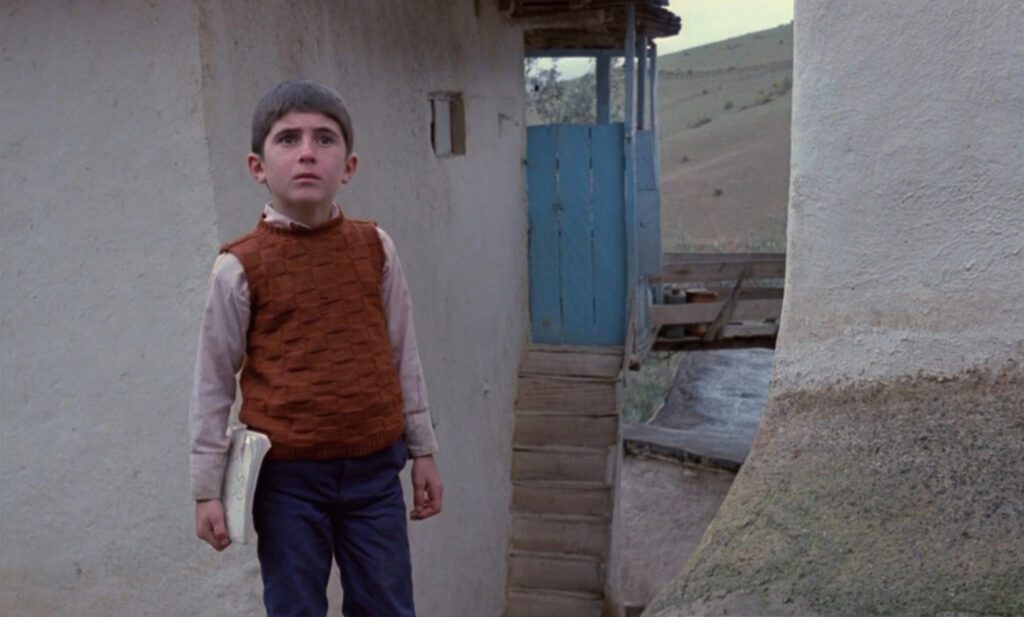
Where Is My Friend’s Home?
1987, directed by Abbas Kiarostami
A strange coincidence occurs in Where Is My Friend’s Home? as Ahmad shuttles back and forth between the towns of Koker and Poshteh, trying desperately to return his classmate’s notebook. In each of the two towns, a man – who in each case happens to be a door vendor – alters the course of Ahmad’s journey. Even if door salesmen are more common in the mountains of western Iran than elsewhere in the world, the coincidence seems improbable and, therefore, significant.
Doors play a conspicuous role throughout the movie, and the difference between the two door merchants will be the key to an ulterior meaning. The opening shot is a door – the door to Ahmad’s classroom, where his friend and classmate Mohamed Reza Nematzadeh gets in trouble for not writing his homework in his notebook. Ahmad will spend most of the movie looking for Mohamed Reza’s home, so it’s only natural that we’ll see a lot of doorways… but even so, it’s pretty clear that the movie puts a deliberate emphasis on doors. Some are memorable, like the blue door at the top of the stairs, or the ornate double doors near the end of Ahmad’s back-and-forth journey that make him realize the old man has led him to the wrong Nematzadeh house.
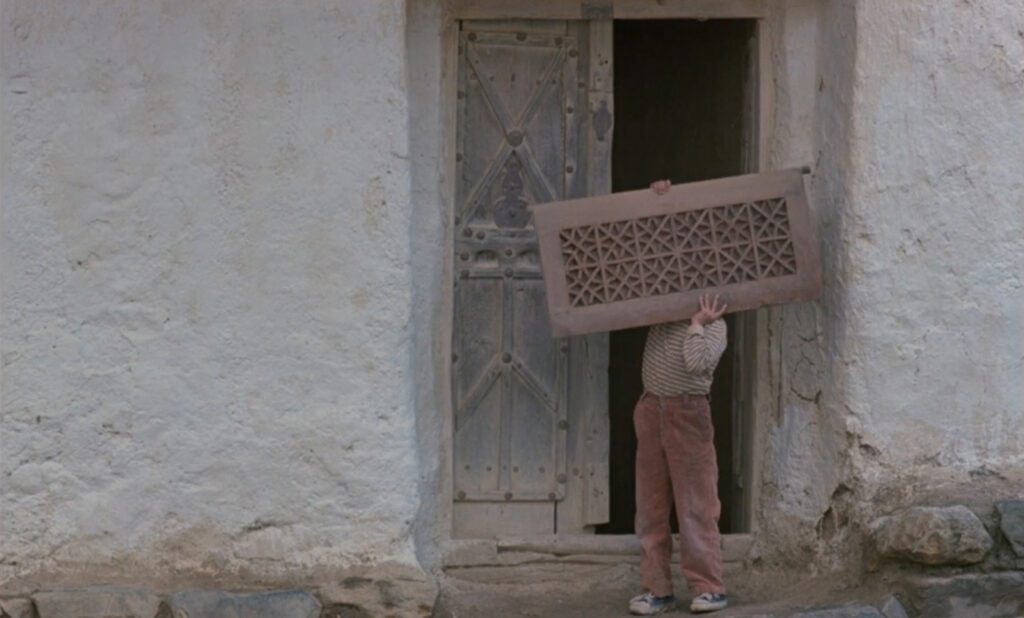
Ahmad meets the first door vendor when he backtracks to his hometown of Koker in the middle of his trip. The door vendor is negotiating with friends of Ahmad’s grandfather and ignores the boy except to demand a page from the notebook he’s carrying. Ahmad then follows him back to Poshteh, believing him to be Mohamed Reza’s father. This merchant boasts that his practical modern iron doors outlast wooden doors and keep houses warm inside.
Returning to Poshteh, Ahmad meets the second door vendor, a much older man who has crafted most of the district’s finely wrought wooden doors and windows, many of them embedded with arabesque lattices or stained glass that cast elegant light patterns on the walls of Poshteh at night. The old door maker laments the replacement of wooden doors with iron, arguing that people need beauty in their lives.
A door is an ambiguous image. It can shut the world out and keep people away, or it can open up and let things in. The two door vendors are a contrast not only in style and materials but also in attitude. Neither is wrong about the advantages of his doors, but each cares about different values. One wants to separate inside from outside, to keep nature at a distance, while the other sees doors as portals to a beautiful world. Each of the two men has an additional secondary trade: the merchant who sells iron doors also makes shutters, whose purpose is to block light and air; the old craftsman who makes wooden doors also makes windows, which are openings to the world. The older man is the only adult who pays any attention to Ahmad, and the movie unmistakably takes his side. The iron door salesman won’t give Ahmad the time of day, but the old man has a long conversation with the boy, tries to help him find his friend, respects his wish to hurry home, and gives him a flower which we find decorating the notebook in the final shot.
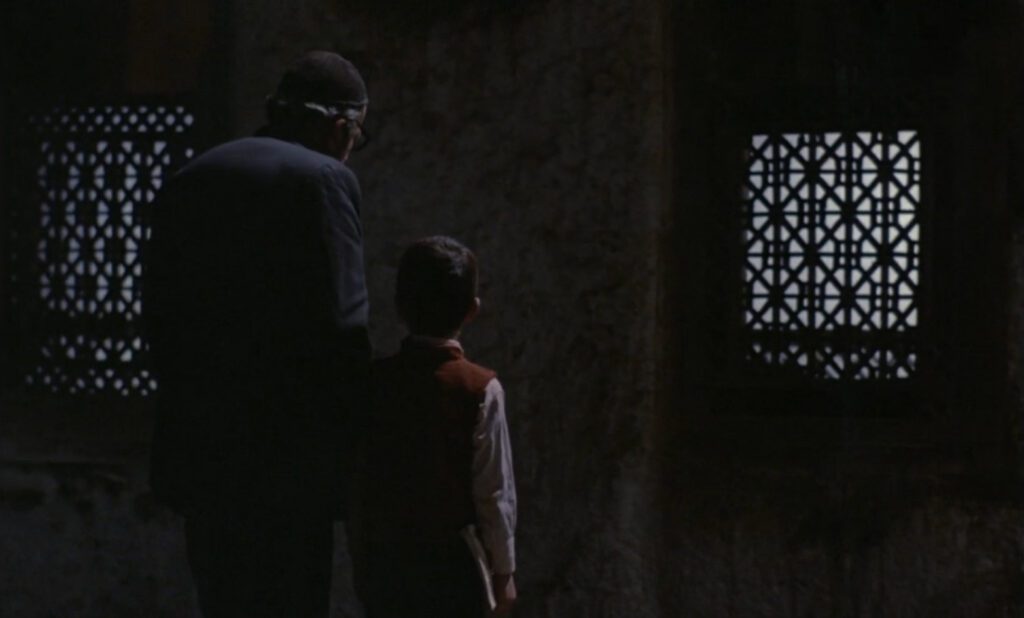
The last significant appearance of a door is at night, after the journey when Ahmad is completing his friend’s homework. Suddenly his door blows open. Obviously this is not a heavy iron door, because it lets wind into the house, but the inconvenience of the wind is counterbalanced by the beauty of sheets blowing in the courtyard. A heavy door could have shut out this force of nature, but Ahmad would have been poorer for it.
By making the old door maker so much more sympathetic than the merchant of iron doors, the movie favors openness to society, to nature, and to the world in general. These implicit values have a political aspect that a movie in Iran cannot express directly.
Iranian movies often feature children, not only because of the nation’s booming population, but because stories about children are a safe subject in a country where religious strictures forbid displays of immoral passions like crime and lust. On the other hand, the outwardly innocent subject of children opens up opportunities for veiled criticisms of authority, especially because relations between children and adults can so easily be likened to relations between citizens and their rulers. The society in Where Is My Friend’s Home? is tyrannical to children. Adults constantly give them orders, and rules smother their freedom: “Be quiet in the classroom.” “Do your assignment in a notebook.” “Bring me a diaper.” “Get some hot water from Granny.” “Don’t wear shoes upstairs.” “Get me the basin.” “Rock the baby.” “Give the baby his bottle.” “Do your homework.” Go to the bakery.” “Throw me the fallen sheet.” “Go get my cigarettes.” “Give me a page of paper.”
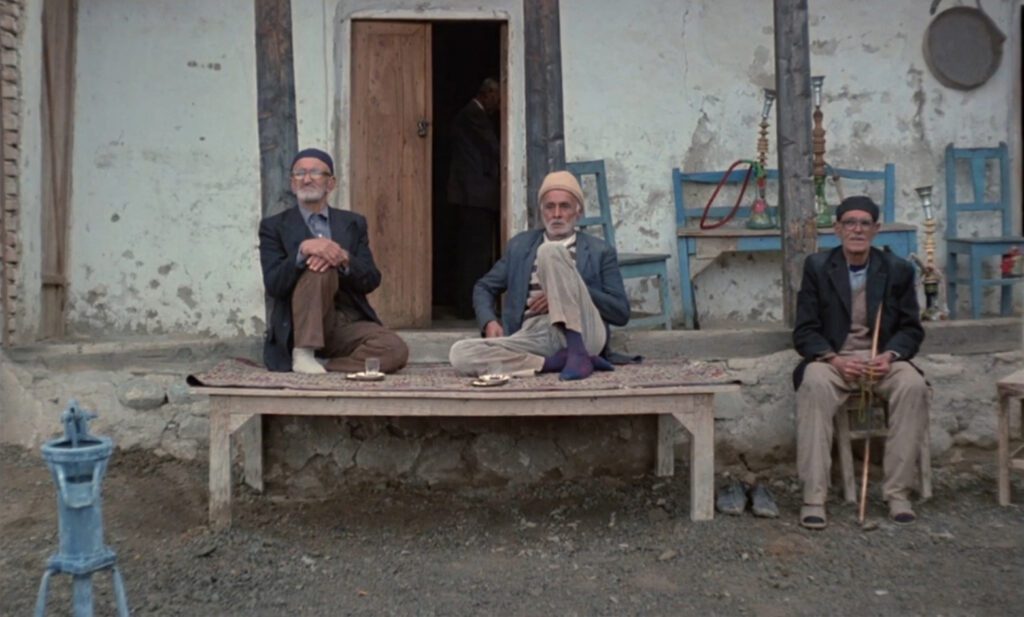
The point is not only the constancy of these demands, but that the adults are so unreasonable. Who could watch this movie without feeling that the teacher is grossly unfair to Mohamed Reza? Or that Ahmad’s mother is unjust in refusing to let him return the notebook? Adults ignore Ahmad whenever he tries to assert himself or ask a question. The first door merchant takes a page from the notebook, ignoring Ahmad’s objections. Ahmad’s grandfather is intentionally unjust to the boy, sending him to get cigarettes he already has and telling Mr. Jamali he would beat a child every two weeks, even if innocent, just to teach the kid a lesson.
The tyranny here, therefore, is not so much a sadistic tyranny as a tyranny of exclusion, ignoring children’s needs, dismissing their rights, or treating them as if they don’t exist. The injustices inflicted on children are consistent with the closed mindset symbolized by the iron doors, shutting children out of sight as a solid door shuts out both nature and neighbors. The movie’s argument calls for a synthesis between liberalism and conservatism, acknowledging a limited need for hierarchy in society but favoring a spirit of open-mindedness that is fundamentally liberal.
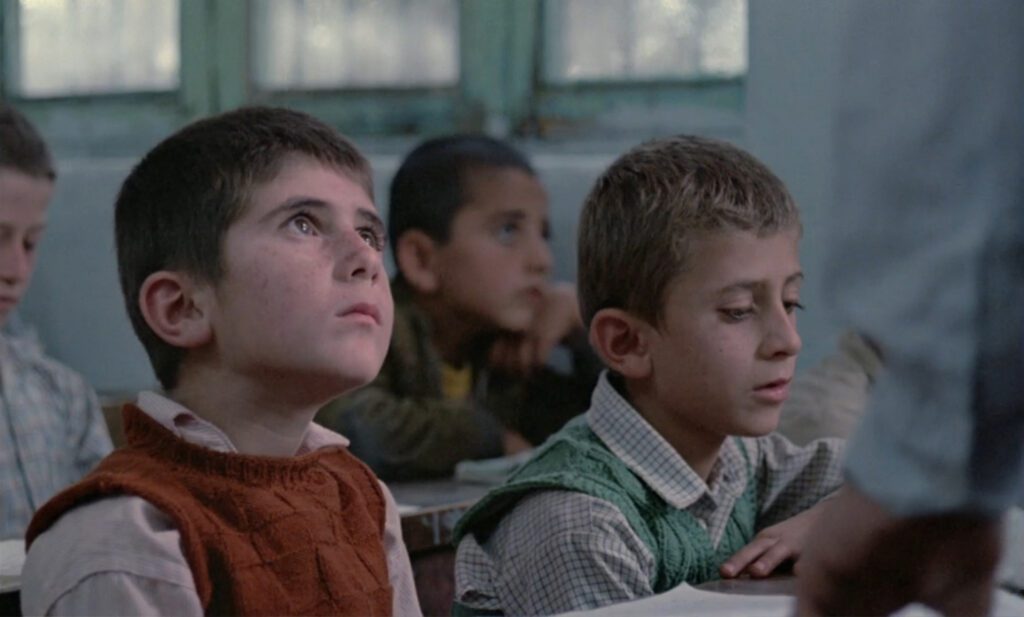
Whether the movie’s position is subversive depends not only on its interpretation, but also on how one regards Iran’s political and religious authorities. Where Is My Friend’s Home? criticizes the abuse of authority, but by representing authority in a relationship as inevitable as that between adults and children, it stops short of opposing authority in general. It is up to viewers to say whether Iran’s rulers are more like the old craftsman or like the other adults. For any opponent of the regime it’s tempting to read a daring political criticism into the movie’s stance, and that may well be justified, but if the critique is there it’s entirely implicit. The theocratic government could hardly object without admitting that they fit the mold of all the unsympathetic adult characters.
In contrast to the other adults, the old doorsmith is a prescription for how adults should act toward children and, simultaneously, how authority should act toward its subjects. He tries to measure his pace to Ahmad’s, and he listens to the boy. His only command to Ahmad is “Take this flower and put it in your notebook.” This might be an imperative sentence, but the old man is not pulling rank on the boy; the command is not an assertion of power. The flower serves as a fitting end to the movie because it shows the appropriate application of authority.
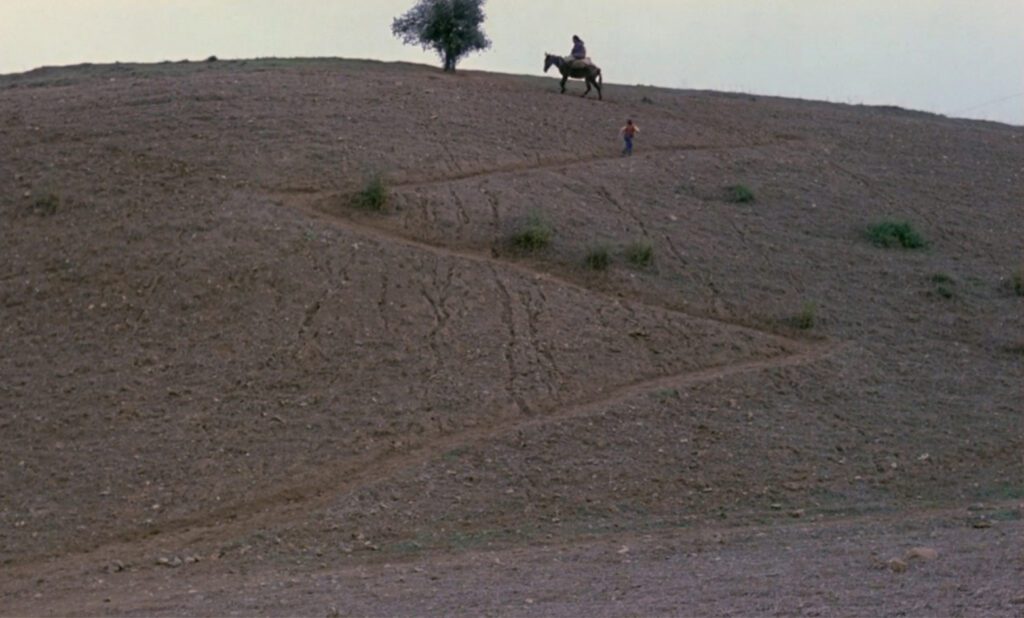
Ahmad himself, however, is an even more eloquent exemplar of behavior than the old door maker. His determination to save his friend from expulsion at all costs reveals an innate sense of justice that puts most of the adults around him to shame. The movie’s most subversive quality is the way it upholds Ahmad’s act of conscience above blind obedience as the essence of virtue.
CONNECTIONS:
Spellbound – Doors as a repeated motif with metaphorical significance
Phone Call from a Stranger – Character’s quest to perform good deed(s); lesson expressed through a duality (two plane flights, two doormakers)
Ugetsu monogatari – Character(s) backtrack in the midst of a journey
Pickpocket – Doors as a repeated motif with metaphorical significance
Run Lola Run – Urgent quest to do a favor for a friend; long scenes of running; unresponsive adults; repetitions
The Wind Will Carry Us – Critique of Iranian clerical rulers
NOTE:
About half the time this movie’s title is translated into English as “Where Is the Friend’s Home?” (or “…House”). Persian nouns are definite by default, but it’s wrongheaded to convert the words into stilted English. Slavish literalism at the expense of good language is a poor translation practice.